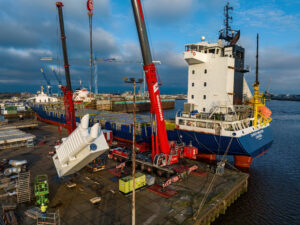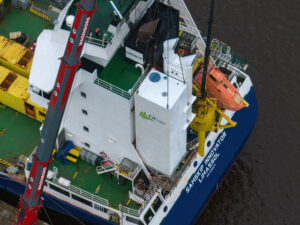Samskip has recently embarked on a new innovative project that will reduce CO2 emissions for its vessels. Samskip’s Carbon Capture and Utilization system is a clever and sustainable application that in real-time captures 30% of the CO2 emissions generated by combustion engines and stores it in portable batteries. These batteries can then be delivered to businesses that utilize CO2 such as agricultural clients and greenhouses which currently use gas-powered machinery to create the CO2 needed to stimulate growth of their products. The captured CO2 can then immediately be used bypassing the need for the gas-powered machinery, in turn reducing the use of natural gas.
23 March 2023 – The Samskip organization has long been recognized as one of the prominent leaders in green logistics and sustainability. Having just received the prestigious EcoVadis Gold Medal for 2023 based on its performance in Environment, Labor & Human Rights, Ethics and Sustainable Procurement, Samskip ranked within the top 2% of its industry peers for all these topics and continues to look for innovative methods to pioneer sustainable solutions and services.

The recent installation of Samskip’s first CO2 exhaust gas cleaning system on one of its shortsea vessels was performed while docked at shipyard Royal Niestern Sander.
Royal Niestern Sander is widely known and respected for its innovative and sustainable ship designs, conversions and projects. Bart Volgers, Director Niestern Sander Repair, said: “In recent years, we have seen more and more ship owners invest in sustainable applications for their ships. Niestern Sander Repair has always been there providing essential support for such initiatives and for proactive innovators such as Samskip and the installation of their Carbon Capture and Utilization system. Such systems effectively reduce harmful emissions while considerably extending the lifespan of such a ship in this era where strict requirements for sustainability are becoming increasingly necessary. We are proud that a pioneer like Samskip is taking on such a project together with our yard.”

Erik Hofmeester, Head of Fleet Management, said: “The Carbon Capture and Utilization system is one of many Samskip initiatives and is also an important step towards reaching the sustainability targets outlined in our latest sustainability report, as we demonstrate our commitment to Samskip’s Science Based Target initiative of reaching Net-Zero by 2040. We believe that the well-being of our planet is everyone’s responsibility. So, we strive to not only drastically reduce our CO2 emissions and focus on the issue of the changing climate and our planet, but we also strive to contribute to the solutions and preserve our ecosystem. We are very excited to launch our first vessel using the CCU system to reduce our emissions, store and utilize the captured CO2 to support other businesses to reduce their use of natural gas. This is the definition of sustainability!”
Note to editors:
Samskip offers pan-European, environmentally responsible combined transport services via shortsea, road, rail and inland waterway routes. We are committed to cost-effectiveness, operational excellence and best practice in sustainable transport. High frequency services connect destinations across Europe, the Baltic States, Iceland and Faroes Island, and Russia, both door-to-door (including collection) and quay-to-quay, transported using a wide range of owned vessels, containers, trucks and trailers. To match equipment to cargoes shipped, options include a full range of ISO containers and reefers, including 33-pallet capacity 45ft units.Samskip’ Global Forwarding division offers global expertise in transporting perishables. With offices throughout Europe, Asia and the Americas connected by state-of-the-art operational software, and backed by a group transporting 800,000 containers every year, we bring fresh food to your markets worldwide.
In all cases shippers can make real choices based on frequency of service, transit times, freight rates and sustainability.
